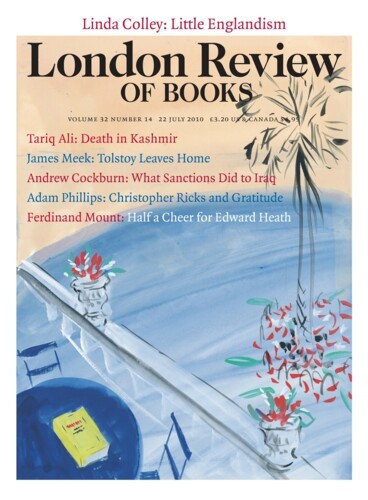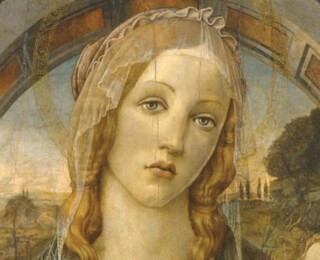In most exhibitions in the Sainsbury Wing the pictures are dominant, the words on the walls discreet. In Close Examination: Fakes, Mistakes and Discoveries the words are large and insistent. It is as though the pictures are being publicly shamed, like criminals paraded with their offences written on placards round their necks. While some of the pictures here are arraigned for no more than hiding behind dirty varnish, inept repairs or later ‘improvements’, and while others must carry the can for not being what they never claimed to be, there are also those that have persistently refused to answer straight questions about their origins and those that are truly fakes, pictures made to deceive. But investigation can go in both directions: there are pictures here that once caused doubts and have now been rehabilitated.
In a way the game would have been more fun if the pictures and the words had been separated. Then, like buyers who look over pictures at an auction without consulting a catalogue, one would have thought harder about a work before reading the evidence for and against. But it isn’t a game. In the visual arts anxiety about authenticity is endemic for good reasons. There is embarrassment when an attribution won’t stick if money was spent – public money in the case of the National Gallery. Curatorial reputations are also at stake. Just as serious is the way a wrong attribution corrupts the body of ideas and images you draw on when, before looking at a gallery label, you decide for yourself that a picture is, say, a Botticelli. Add or subtract from the canon and you change what ‘a Botticelli’ means.
It is notorious that fakes and misattributions can fool one generation but be obvious to the next. Moreover, even the most distinguished connoisseurs sometimes differ, so scientific tools capable of confirming or overturning human judgment have been picked up quickly: X-rays (almost as soon as they were discovered) and then dendrochronology, infrared and ultraviolet imaging, gas chromatography and various sorts of microscopy.
In 1874, when the collection of Alexander Barker, the son of a fashionable boot-maker, came up for sale at Christie’s, the National Gallery acquired two Botticellis: both long pictures of Venus, one with three putti (An Allegory), the other with four baby satyrs and Mars (Venus and Mars). An Allegory now seems clearly an oddity – maladroit, not even pretty. To force it onto the Botticelli template would destroy the coherence the accepted canon gives his work. Yet when it was bought it was not only accepted – even by some who thought it second-rate – but also cost a third more than Venus and Mars. The reputation of An Allegory soon went downhill; by 1951 the curator Martin Davies wrote that it was by ‘some feeble imitator of Botticelli’. It is certainly, according to all the tests, an old picture: the support, ground, pigments and medium are appropriate for Italy around 1500. Science in this case can only say that the attribution might be wrong, but the object is sound. Venus and Mars meanwhile has seen its reputation rise, and today ‘still hangs on the main floor … his most celebrated mythological painting outside the Uffizi’.
Sixteen years earlier the gallery had bought a painting attributed to Filippino Lippi and dated 1492 of Saint Francis of Assisi with Angels. After it was cleaned and re-examined in 2002 it was redescribed as a Botticelli of 1475-80. The 1492 date had been a later addition: the resemblance to other Botticellis of the 1470s was established, with the green in the angels’ draperies identified as coming from a source of malachite that had provided pigments for other Italian paintings of the period. An infrared reflectogram (which makes the under-drawing visible) showed that the painter had had trouble with the position of the feet (so the picture isn’t, as Bernard Berenson suggested, a copy).
Then there is the Madonna of the Veil, bought expensively by Lord Lee of Fareham in 1930 and bequeathed to the Courtauld Institute in 1947. It was accepted by London experts in the 1930s as a masterpiece by Botticelli, but the feeling that something was wrong about it grew. Kenneth Clark said the Madonna had ‘something of the silent cinema star about her’ (he mentioned Jean Harlow), and the too full lips, the baby-doll look, now seem very un-Botticelli: the picture refuses to fit the template. The models and film stars that define our current paradigm of beauty are not much like Jean Harlow; if they were, the feeling that something is wrong would perhaps not be so strong. She is now attributed to Umberto Giunti (1886-1970), a lesson for art-history students in both how skilful and how careless forgers can be. We are sure she is not who she says she is because the painter used a number of pigments not available before the 19th century; moreover, damage that seems to have been done by time is the result of intentional attack, and stress marks around holes in the wooden panel suggest that they were made by a drill not a worm.
Sometimes desire warps judgment. In the 1930s, when Kenneth Clark was the very young director of the National Gallery, there was no Giorgione in the gallery’s otherwise magisterial collection of Venetian Renaissance paintings. Clark persuaded himself that four small panels he was shown were by Giorgione, or someone in his circle. The trustees pressed him to go further and say they were indeed by Giorgione. He did; the panels were bought and when exhibited immediately met loud and expert scepticism. They are now attributed to Andrea Previtali. It was a costly and embarrassing mistake that made the gallery nervous about later attempts to fill the gap. They did in the end get their Giorgione, or rather they got a much damaged painting that has a percentage of work by his hand. It is called Il Tramonto (The Sunset), which reflects the fact that the figures of Saint George and the dragon, which might seem to provide an obvious title, were added by restorers repairing the picture with pieces of old canvas: an X-ray shows an amazing patchwork of scraps although the central landscape and the sunset are in comparatively good nick.
You can’t rule out mischief. A picture, a little under a foot square, Portrait of a Man (Victor Considérant?), supposedly by Delacroix, was given to the Tate Gallery in 1922 by Walter Sickert. The picture had a provenance of sorts – there is a record of it being exhibited at the Eldar Gallery in 1920 – but when it was transferred to the National Gallery in 1956 the curator Martin Davies questioned the attribution and the title. It didn’t look very like other portraits of Considérant, nor was it entirely convincing as a Delacroix. Sickert was friends with the owners of the Eldar gallery and exhibited there: could he have painted it himself? Did he buy it, or exchange it for something of his own? In this case the materials raise no questions and science has nothing to say.
Sickert, writing to the Times in 1927 about impertinent forgeries of Impressionist painters, claims that ‘it is easy to pass forgeries of (1) slight or (2) incomprehensible paintings … No one nowadays is skilful or laborious enough to forge a Meissonier or a Ford Madox Brown that would deceive even a professional expert.’ He was wrong about the skill: look at the Giunti Botticelli, which could have been on the easel when he wrote. But slight sketches, if you can get into your painter’s way of making marks, and have a cunning way with false documentation, are a more economical route to success in the auction room. In such works the forger and connoisseur are engaged in a game that sets skill against skill, much practising against much looking and remembering. Science can call the match off if the stuff the picture is made of is wrong. Otherwise the problem is to know the work of an artist so well that you can say with assurance that it doesn’t fit the template and that he or she could not have made it.
But while the Madonna of the Veil, if accepted as canonical, would do damage, there are paintings that go on being good after deattribution. The painting Sickert gave the Tate is small, dark and looks to be quickly done. Although the gallery is not willing to venture its author, it is still an interesting picture. The two erstwhile Rembrandts in the exhibition were eventually assigned to unidentifiable students or assistants; but they are interesting to look at, too. We can still admire them, do our best to look past their powerful Rembrandt-like qualities and find touches and ways of working that might identify the anonymous worker who made them.
Send Letters To:
The Editor
London Review of Books,
28 Little Russell Street
London, WC1A 2HN
letters@lrb.co.uk
Please include name, address, and a telephone number.


